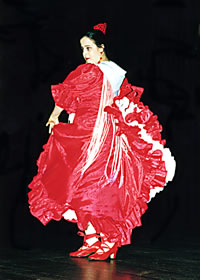Ana Maria: Flamenco
 Some people do yoga, some practise a sport or go to the gym, others ... dance!
Some people do yoga, some practise a sport or go to the gym, others ... dance!In the middle of Sydney's Inner West we find a little Spanish corner, Ana Maria Campo's Spanish School of Dance. My friend Olga Yoldi talks to her about the school, her students and herself.
Listen to Ana Maria
 Download the MP3 file (3.28 MB, o:03:35)
Download the MP3 file (3.28 MB, o:03:35)music by Coro de La Hermandad de Nuestra Sra del Rocio de Jaen
To help you with the listening, here are some questions:
1. How did she become involved in flamenco?
2. When did her mother migrate to Australia ?
3. How does Ana Maria describe flamenco?
4. Why do people do it?
5. What nationalities are the students?
6. What’s the history of flamenco?
7.Why has she settled in Australia?
8.What’s her identity?
9. What else does Ana Maria do?
10.What does versatile mean?
11. How does Ana describe herself?
12. How many children does Ana Maria have?
13.What did her husband do in order to be able to see her when they were courting?
14. Where is he from? Does it make a difference?
For more information on flamenco and its origins, visit Flamenco-Widipedia
- Search the net: Is there a traditional dance in your country of origin that is very popular? Write a short information text (report) about it. Here is an example of a report about the jota, a traditional dance form Aragon, Spain. You can also search for a video (youtube is a good site) which shows traditional dances from your area and post it on your blog.
For a general overview of Aragonese dances, check this video, also from Agrupacion Santa Cecilia. All of the places shown are from the Pyrenees, the mountains in the north of my province, Huesca.
Labels: esl, ESL podcasts, esol, multiculturalism, podcasting, Sydney




 Previous
Previous


